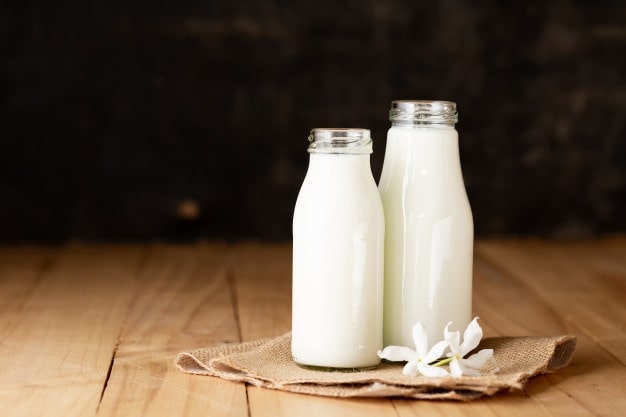Non-dairy Milk Versus Cow Milk: Benefits and Comparison
- 42 months ago
Introduction
Good quality, healthy raw milk must be free of added flavors and have excellent organoleptic properties and a low bacterial count. The primary reason for the increased demand for milk alternatives is lactose intolerance. The other reasons are veganism, milk allergies, concerns about inflammation, Crohn’s disease, colitis, and concerns about antibiotics, pesticides, hormones, and ethical beliefs.
For some people, stomach aches, headaches, or allergic reactions are the motives for switching from dairy to non-dairy milk alternatives. Others may want milk alternatives for different tastes or texture preferences. Whatever the motivation, there are various non-dairy milk alternatives.
Some of the different types of plant-based milk products include-
● Almond milk
● Cashew milk
● Oat milk
● Soy milk
The article explores the nutritional values, pros and cons, and cost-effectiveness of almond, cow, oat, cashew, and soy milk from a health perspective.
Nutritional Values
|
|
Almond Milk |
Cow Milk |
Oat Milk |
Cashew Milk |
Soy Milk |
|
Calories |
41 |
149 |
130 |
160 |
101 |
|
Protein |
1.01 g |
9 g |
4.01 g |
5 g |
6.0 g |
|
Total fat |
2.50 g |
10.99 g |
2.50 g |
14 g |
3.5 g |
|
Sugars |
0 g |
31.01 g |
19.01 g |
3 g |
9.0 g |
|
Calcium |
45% of DV* |
28% of DV* |
27% of DV* |
250 mg |
451 mg |
|
Vitamin D |
101 IU |
25% of DV* |
18% of DV* |
101 IU |
26% of DV* |
|
Vitamin E |
50% of DV* |
98 IU |
NA |
NA |
NA |
|
Riboflavin |
26% of DV* |
0.447 mg |
46% of DV* |
NA |
26% of DV* |
* = Daily Value
Almond Milk
Advantages
#1. It is free of cholesterol, saturated fat, and lactose. Further, it is a rich source of healthy fats, calcium and vitamins D, E, and A. Hence, it can strengthen bones and reduce cardiovascular risks.
#2. Almond milk has fewer calories than other types of milk. Further, it can be consumed by individuals who are lactose intolerant and those looking for weight loss.
#3. It is significantly low in calories (80% fewer than cow’s milk), fat, and protein and has no cholesterol.
Disadvantages
#1. It is unsuitable for those with nut allergies.
#2. Further, in contrast with cow’s milk, it has less calcium, proteins, and vitamins.
Oat Milk
Advantages
#1. It is naturally sweet, creamy, and has a mild flavor. These factors make it suitable for consumption with cereal, hot beverages, and cupcakes.
#2. It is high in carbohydrates, riboflavin, and vitamin B12 and extremely low in fat.
#3. Oat milk contains soluble fiber that absorbs water and turns into a gel during digestion. Therefore, it helps slow the digestive process and can keep you fuller for longer.
#4. It stabilizes blood sugar and cholesterol levels.
Disadvantages
#1. May contain high levels of added sugars and carbohydrates.
#2. Not as nutrient dense as other milk alternatives.
Cashew Milk
Advantages
#1. It has a creamy texture and mild taste.
#2. It is a rich source of calcium, vitamins D, E, and can improve bone health
#3. Rich in antioxidants cashew milk boosts immune health and is good for the skin.
#4. Further, it has anti-cancer properties.
Disadvantages
#1. It may contain high levels of added sugars.
#2. It is unsuitable for those with nut allergies.
#3. Not suitable for people prone to (calcium oxalate) kidney stones.
Soy Milk
Advantages
#1. It was the first plant-based alternative to come up in the United States market.
#2. Comparing soy milk with almond and oat milk, the former has the highest amount of protein per serving.
#3. It has isoflavones that have anti-cancer effects.
Disadvantages
#1. Soy milk varieties might have high levels of phytate and oxalate, compounds that block calcium absorption.
Cow Milk
Advantages
#1. Cow's milk has about 25% to 30% of the daily recommended bone-building calcium.
#2. It contains muscle-strengthening proteins, vitamin D, magnesium, and phosphorus.
Disadvantages
#1. It contains a sugar called lactose that can be hard to digest. Further, it cannot be consumed by people who are lactose intolerant.
#2. Cow’s milk contains a large amount of fat and can cause weight gain.
#3. It contains natural bacteria, such as Escherichia coli (E. coli) and Salmonella, which can cause diarrhea, vomiting, inflammation, and indigestion in some people.
#4. Several studies have explored the association of cancer risk and dairy usage and found a lower risk of colorectal cancer in individuals who have a high dairy diet.
Cost-effectiveness of Different Types of Milk
The following table indicates the average prices for different types of milk available in the market per liter.
|
Milk |
Avg. Cost INR |
|
Cow |
INR 47 to 49/lt |
|
Almond |
INR 325 to 700/lt |
|
Soy |
INR 100 to 150/lt |
|
Cashew |
INR 600 to 1,000/lt |
|
Oat |
INR 450 to 650/lt |
Compared to a liter of regular or organic cow milk, which is, on average, INR 45/lt, alternatives are much more expensive for the same volume.
Bottom Line
● Milk is an excellent source of antioxidants and essential nutrients such as potassium, calcium, phosphorus, riboflavin, vitamins A, E, D, B12, K, B1 (thiamine), zinc, beta-carotene, and magnesium. Therefore, it can help regulate bone health and reduce age-related muscle loss, inflammation, and oxidative stress. Moreover, it contains large amounts of proteins and several different fatty acids such as omega fatty acids and linoleic acid that can decrease the risk of heart diseases and diabetes.
● Dairy products are rapidly taking over non-dairy plant-based milk and beverages due to vegan consumers and people who are dieting or medically unfit to use milk. However, compared to cow's milk, all other substitutes are significantly lower in nutrients and much more expensive.
● The best policy is to use all types of milk in balanced quantities, as they all offer different health benefits, such as reducing cholesterol, cardiovascular protection, promoting antioxidant intake, and providing essential nutrients.
● While selecting non-dairy milk alternatives carefully check the sweeteners, added nutrients, flavors, preservatives, and thickening agents.








